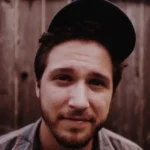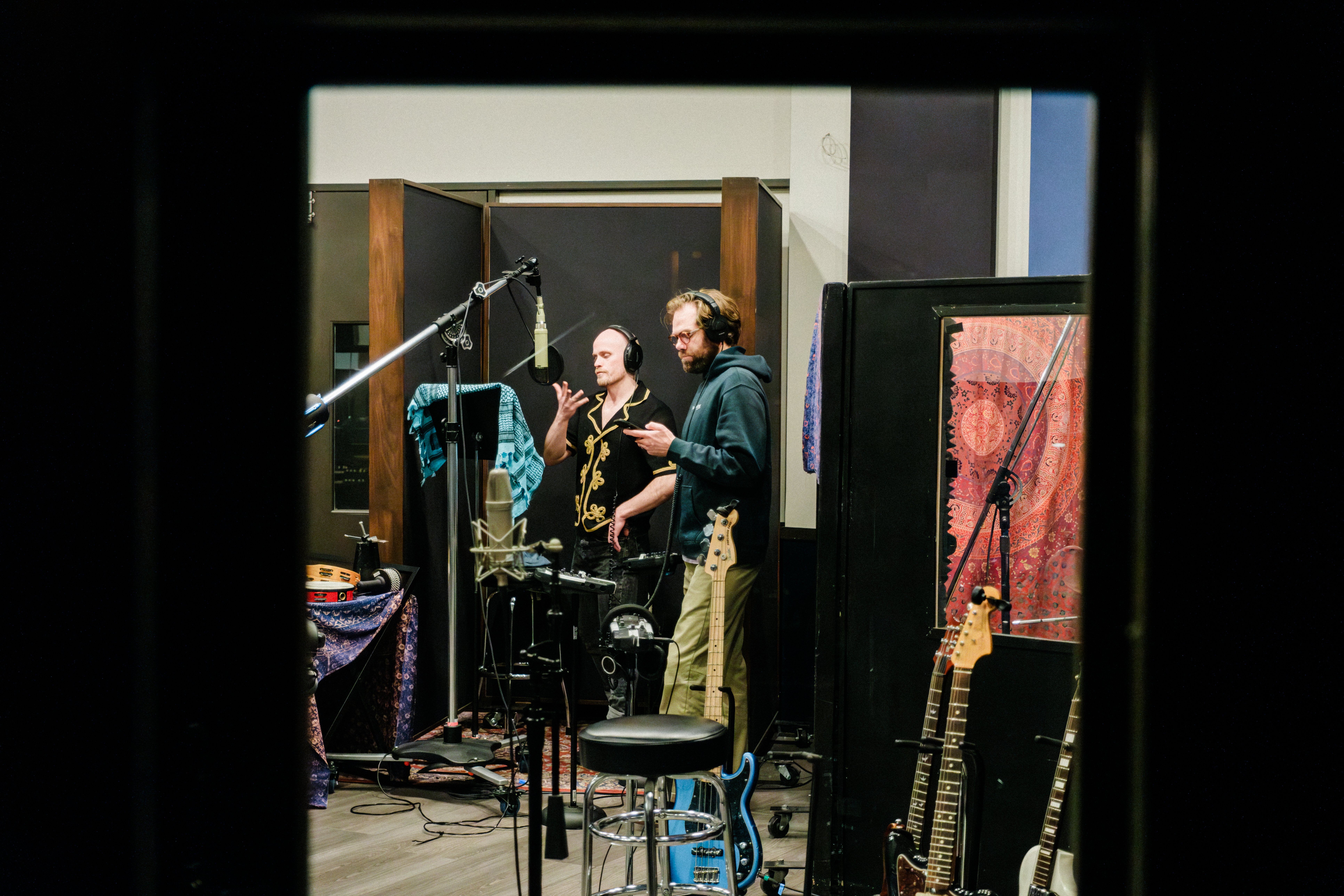Why doesn’t your acoustic guitar shine through your mix like you want it to?
Why does your electric guitar sound like garage-band quality?
It might very well be the quality of your microphone.
Your mic is the gateway to your recording. It doesn’t matter how good your guitar sounds to your ears if your mic can’t accurately capture the sound.
So I want to talk about the best guitar mics for recording at home…
Condenser vs Dynamic: Which Microphone Is Better for Guitar?
There are two types of microphones that every professional recording studio has. (There are more, but we’re just going to be covering these two.)
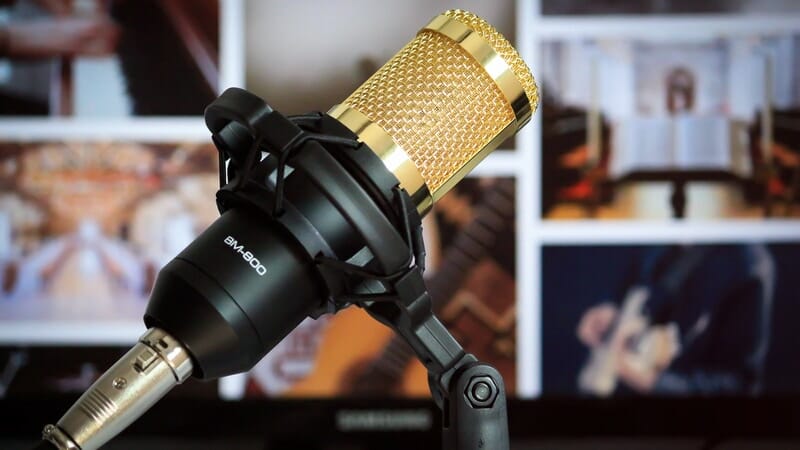
Before we talk about which type might be better for recording guitar, we have to familiarize ourselves with each.
The key factor is something called a transducer.
The way a mic’s transducer works will tell you if it’s a condenser or dynamic.
How Do Condenser Microphones Work?
Condenser microphones have an electrically charged diaphragm.
They’re super precise and clear. But they’re also pretty fragile.
Avoid these sure-fire ways to ruin your condenser:
- Dropping or banging it
- Recording a sound source that’s too loud for the diaphragm
- Storing it in extreme weather conditions (too hot, too cold, too humid, etc.)
Because it runs on electrical circuitry, a condenser mic needs external power to work.
Usually this means phantom power. Most audio interfaces have a phantom power switch or button—you need this turned on for a condenser mic to work.
How Do Dynamic Microphones Work?

Dynamic microphones use a combination of a magnet and a voice coil wrapped in a plastic diaphragm.
It doesn’t have as much electrical circuitry. And this means dynamic mics are much more durable than condenser microphones.
They can handle much louder sound sources.
They’re great as performance mics because they can be waved around and handled roughly.
And most of the time, they’re more affordable than condenser mics—and they still sound great!
When to Use Each Microphone
Generally speaking, condenser mics are better for acoustic guitar. And dynamic mics are better for miking electric guitar amps.
Condenser mics usually work better on quieter, high-frequency instruments. Dynamic mics work better on louder instruments with more low to mid frequencies.
This isn’t a catch-all though.
Sometimes dynamic mics sound great on acoustic guitar. And sometimes condenser mics can work on an amp.
But that’s a general guideline you can start with.
How to Mic an Acoustic Guitar
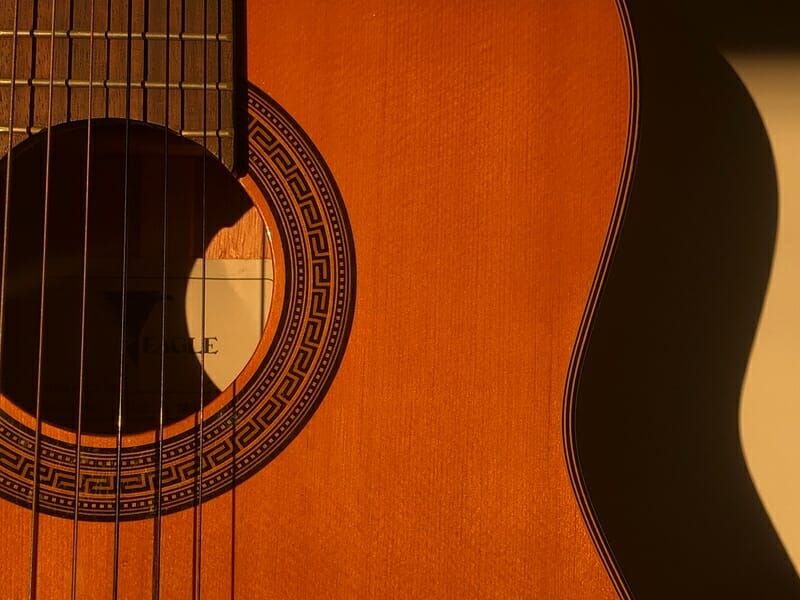
You have many options for miking an acoustic guitar.
They’re all effective, and they all will give you a slightly different sound.
It’s just a matter of what sound you want.
Using One Microphone
If you have just one microphone, don’t fret (sorry for the pun). You can still get a good sound from your acoustic!
The first technique is to grab your favorite condenser or dynamic mic and set it up in front of your guitar.
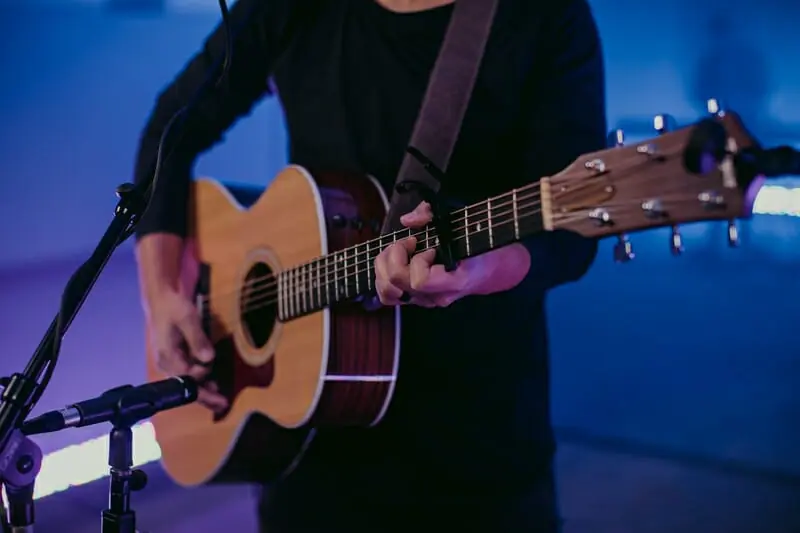
Point it at the spot where the fretboard and body meet and keep it 7–10 inches away from the guitar.
Since every room, mic, and guitar are different, this isn’t an exact science.
You’ll have to move the mic around until you hear the sound you want.
Just don’t point the mic directly at the sound hole—the low end will overpower the whole recording.
You can also use an omnidirectional microphone (condenser or dynamic). It captures sound from all sides.
With this type of mic, you can line it up with the sound hole about a foot away. Again, you’ll have to move the mic around until you find the sound you want.
Using Two Microphones
If you have two microphones, you have more options.
The first technique is to put one condenser mic right at the 12th fret. This will capture the brightness of the strings.
Put a second mic (condenser or dynamic) between the bridge and the butt of the guitar, pointed right at the body. This will capture the lower frequencies of the guitar.
When you do this, follow the 3:1 rule. The distance between the two mics should be at least three times the distance the mics are from the guitar.
So if the mics are each 7 inches away from the guitar, they should be 21 inches apart from each other.
Then you can pan these two mics to get a nice full acoustic guitar sound!
The second technique is the XY setup, which works best with condenser mics. Point one mic at the 12th fret and the other one at the body, making an X or a Y shape.
This technique gives you a nice range of frequencies to work with. Plus, it helps you avoid phase cancellation.
There are tons of other ways to mic an acoustic guitar, but these are the best ones to start with.
How to Mic an Electric Guitar Amp
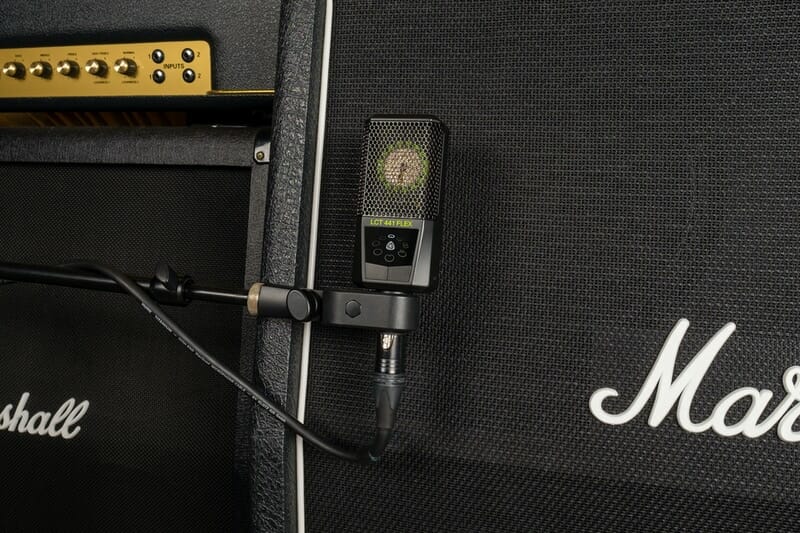
There’s a bit more experimentation with miking an electric guitar through an amp. In most cases, however, you’ll need to use a dynamic microphone.
The main thing to know is this…
The closer the mic is to the center of the speaker, the more brightness you’ll get. Moving the mic outward away from the center of the speaker will give you more bass.
Here’s another way to say this:
The center of the speaker will give you more of an aggressive sound. The edge of the speaker will give you a mellower sound.
Plus, if the mic is on-axis (pointed directly at the amp), you’ll get more clarity. And pointing it off-axis will give you more room tone.
As for the mic’s distance away from the amp, the further away the mic is, the more diffused the sound will become.
Every amp and microphone is different, so you’ll have to find the sweet spot.
Some people will put their ear up to the amp while they play so they can find the spot they want.
Once you find the spot for your microphone, you can put a little piece of tape there. Whatever the case, you’ll have to spend time searching for the sound you want.
The Best Guitar Mics
Now you know how to mic both acoustic guitars and electric guitars. Let’s dive into the best mics to use (both condenser and dynamic).
Shure SM57
Shure is one of the most trusted names in the microphone world. And for good reason.
Go to any concert, and you’ll see a Shure SM58. It’s what you picture when you think of a stage mic.
The SM57 is the 58’s sibling.
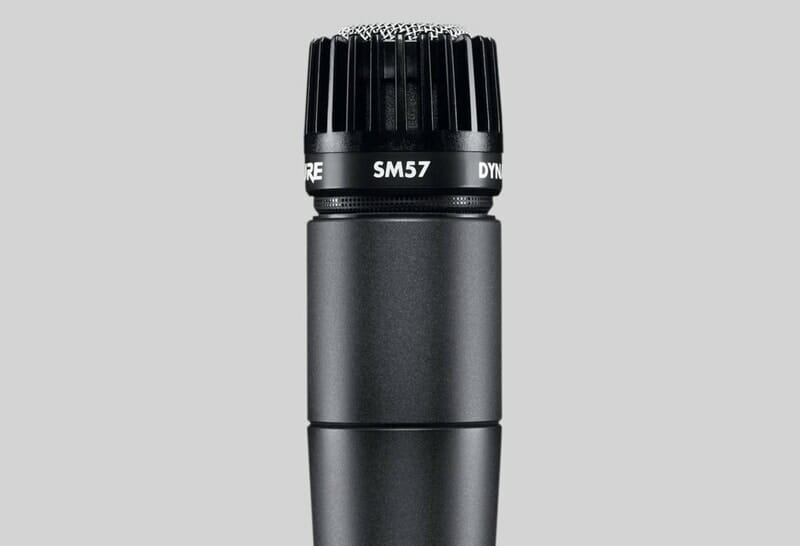
They’re essentially the same microphone, other than the metal grill that covers the 58’s capsule. It helps cut down on plosives, which is why it’s a good vocal mic.
Because the SM57 doesn’t have the metal pop filter, it’s perfect for instruments.
It’s a dynamic microphone. So it’s great for more aggressive instruments, like electric guitars.
And it has a cardioid pickup pattern, so it only captures what’s right in front of it.
If you’re looking for a dynamic mic, the SM57 should be one of the first you consider.
Sennheiser e 609
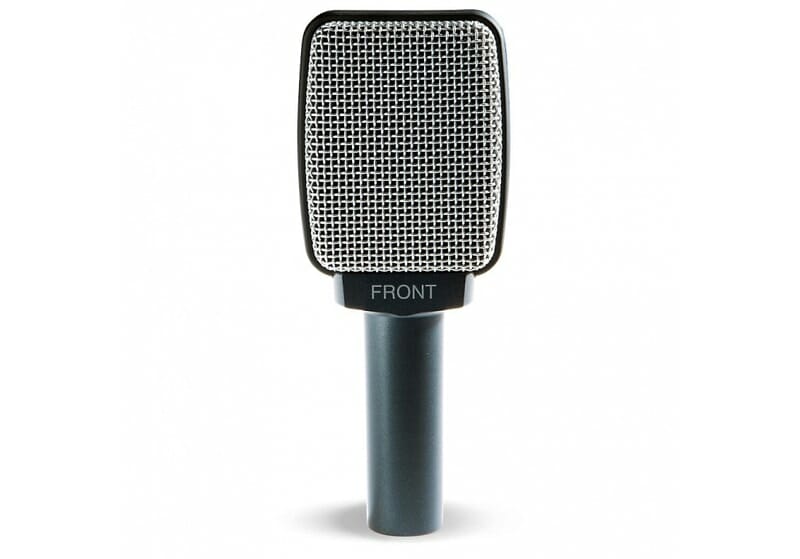
Professional audio engineers compare the Sennheiser e 609 to the SM57. They are similar, but they capture slightly different sounds.
The e 609 is a dynamic microphone, and it seems to be warmer and fatter than the SM57. So it can actually work well alongside a 57.
The unique thing about the e 609 is its supercardioid pickup pattern. It captures sound directly in front of it and some sound directly behind it.
The pickup pattern is very tight front to back, so it doesn’t pick up much sound from the sides.
This helps you isolate the sound you want, avoid reflected frequencies and room noise, and lessen the chance of feedback.
Because the pickup point is so precise, it needs to be focused on a certain area that doesn’t move.
This, along with it being a dynamic mic, makes it best for guitar amps and not acoustic guitars.
When you play an acoustic guitar, you typically move around a bit. That can be noticeable in the recording with this mic.
Bluebird by Blue Microphones
The Bluebird is possibly one of the prettiest-sounding mics I’ve ever used. It’s clear and crisp but not too tinny.
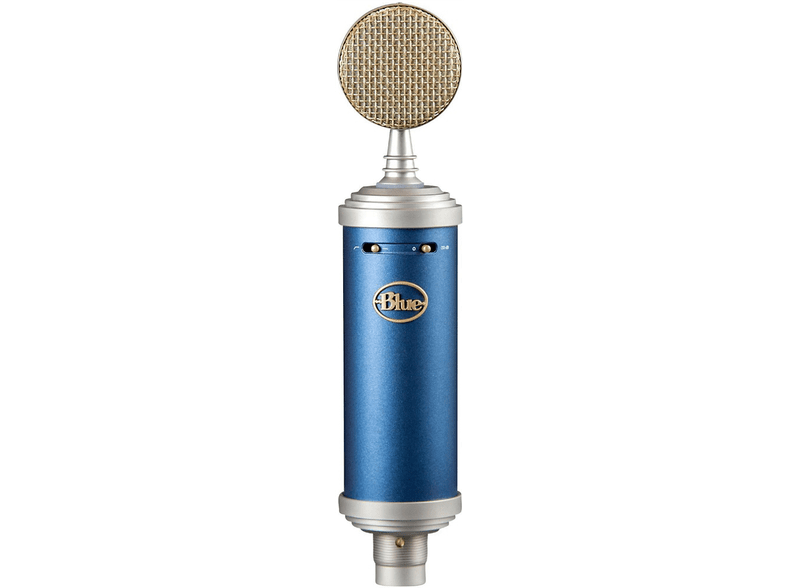
It captures smooth and detailed sound and has a wide dynamic range.
This mic works really well on acoustic guitars for two reasons. Because it’s a condenser mic and because it captures such detail.
Audio-Technica AT2035
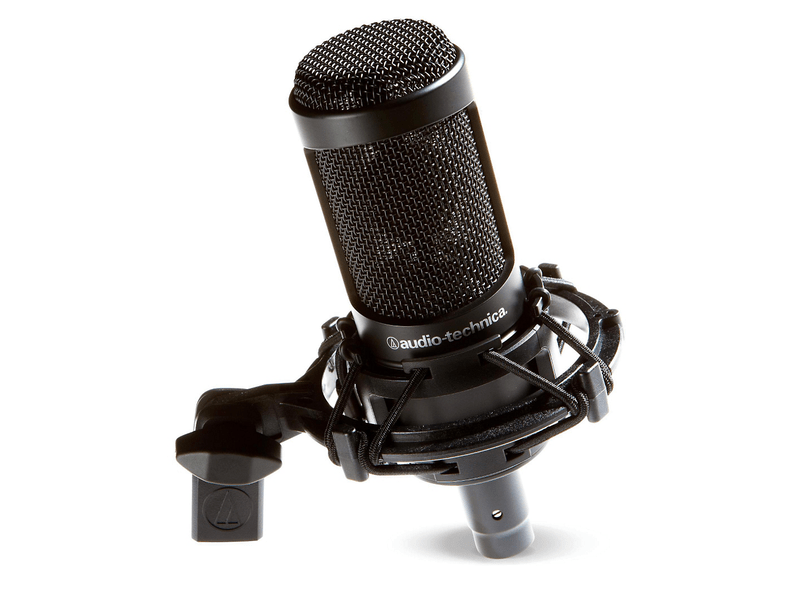
If you don’t quite have the budget for the Bluebird, an AT2035 is a more affordable alternative.
It’s a condenser microphone that also captures very detailed audio.
Plus, it has a low-pass filter switch that helps cut down on low-end rumblings at the source. It also has a −10 dB switch to help reduce room noise.
If you’re recording at home on a smaller budget and you need a condenser mic, the AT2035 is a great option.
Cascade Fat Head
Remember when I said there are more than two types of mics? Fat Heads are ribbon microphones.
This means they have a rich, warm tone that boosts the low mids.
Fat Heads are great for electric guitar. Especially when paired with a condenser.
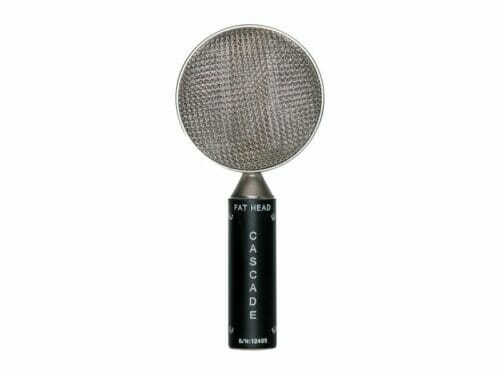
The Fat Head captures the silky lows, while the condenser focuses on the high mids.
You end up with the classic smile curve EQ.
AKG P170
The AKG P170 is a pencil condenser. It has a thin, cylindrical shape like a pencil.
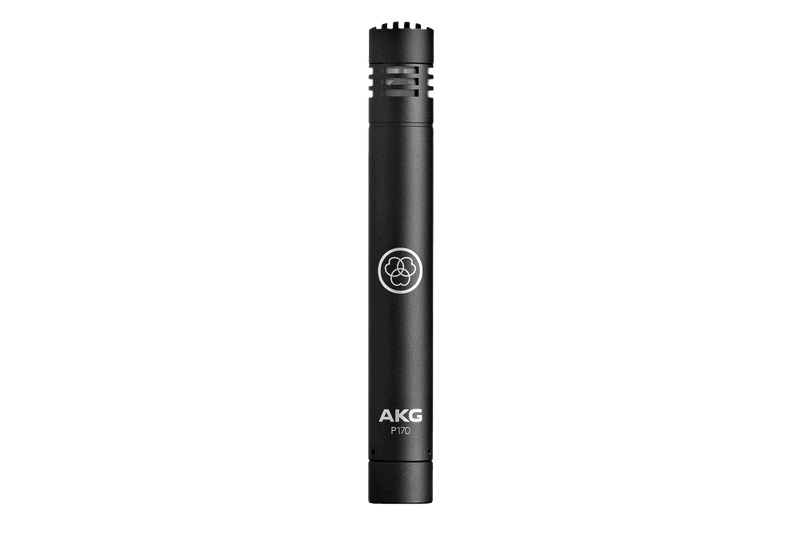
Pencil condensers tend to have much flatter frequency responses than regular condensers. They’re perfect for when you want your recording to sound crystal clear!
And that’s why the P170 is great for tracking acoustic guitars. Acoustics cover a broad range of frequencies.
A pencil condenser will preserve the brightness of the highs and the warmth of the lows.
Try using two P170s in an XY pair!
Røde NT4
The Røde NT4 is a stereo microphone. It’s basically two mics in one.

The NT4’s capsules are automatically set as an XY pair.
No more hassle or headache during setup! Just throw an NT4 on a stand, and you’re ready to go.
Since the NT4 has such a small diaphragm, it’s nice and clear like any pencil condenser. I recommend using it for acoustic guitar.
Conclusion
Now you know how to properly mic an acoustic guitar and an electric guitar. You also know what the best guitar mics are.
All you have to do now is get recording!

